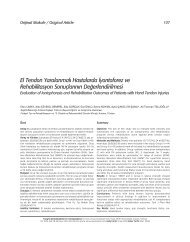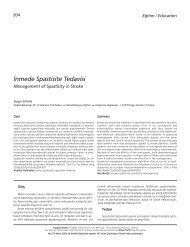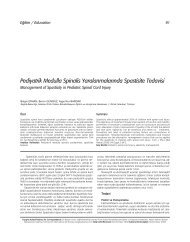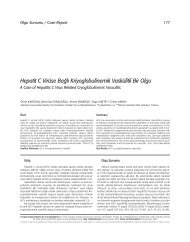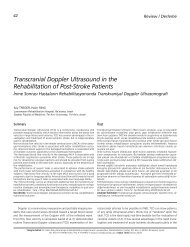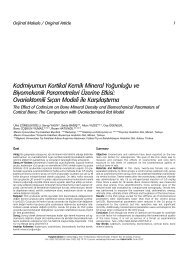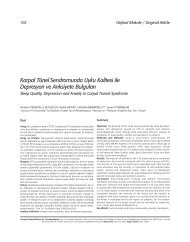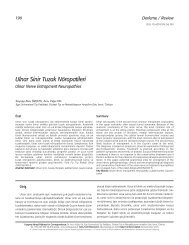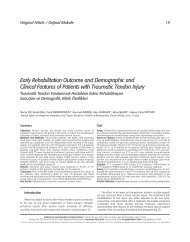Effects of Mental Activity Training Linked With Electromyogram ...
Effects of Mental Activity Training Linked With Electromyogram ...
Effects of Mental Activity Training Linked With Electromyogram ...
You also want an ePaper? Increase the reach of your titles
YUMPU automatically turns print PDFs into web optimized ePapers that Google loves.
Original Article / Orijinal Makale<br />
DO I: 10.4274/tftr.58751<br />
Turk J Phys Med Re hab 2013;59:133-9<br />
Türk Fiz T›p Re hab Derg 2013;59:133-9<br />
<strong>Effects</strong> <strong>of</strong> <strong>Mental</strong> <strong>Activity</strong> <strong>Training</strong> <strong>Linked</strong> <strong>With</strong><br />
<strong>Electromyogram</strong>-triggered Electrical Stimulation on<br />
Paretic Upper Extremity Motor Function in Chronic Stroke<br />
Patients: A Pilot Trial<br />
Kronik Felçli Hastalarda Paretik Üst Ekstremite Motor Fonksiyonları Üzerinde Elektromiyografi<br />
ile Tetiklenen Elektrik Stimülasyonu Eşliğinde <strong>Mental</strong> Aktivite Eğitiminin Etkileri: Pilot Çalışma<br />
Su-jeon You, Jong Ha Lee<br />
Department <strong>of</strong> Physical Medicine & Rehabilitation, School <strong>of</strong> Medicine, Kyung Hee University, Seoul, Republic <strong>of</strong> Korea<br />
Sum mary<br />
Objective: To study whether mental activity training linked with<br />
electromyogram-triggered electrical stimulation (MAT-EMG) improves<br />
motor function <strong>of</strong> a paretic upper extremity in chronic stroke patients.<br />
Materials and Methods: Eighteen patients with chronic stroke for<br />
more than 12 months were included in the study. Nine patients were<br />
randomly allocated to MAT-EMG and 9 to generalized functional electrical<br />
stimulation (FES) on the forearm extensor muscles <strong>of</strong> the paretic extremity<br />
20 times over 4 weeks, for 40 minutes/session. Outcome measures were:<br />
active range <strong>of</strong> motion (ROM) <strong>of</strong> the wrist joint, strength <strong>of</strong> the forearm<br />
extensor muscles, the modified Ashworth scale (MAS), Fugl-Meyer motor<br />
assessment for the upper extremity (FMM-UE), motor activity log (MAL)<br />
and the modified Barthel index (MBI) scores.<br />
Results: The group receiving MAT-EMG improved by 6.13 points in FMM-<br />
UE scores (p
XXXX You et et al. al.<br />
<strong>Mental</strong> <strong>Activity</strong> KISA BAŞLIK in Chronic Stroke<br />
Introduction<br />
Paresis <strong>of</strong> the upper extremities after stroke may limit the<br />
overall function in patients and has a negative effect on body<br />
image, resulting in psychological problems. In patients with<br />
little or no volitional action at paretic sites after 6 months or<br />
longer, contracture <strong>of</strong> the joints, loss <strong>of</strong> motor skills, and wholebody<br />
dysfunction may worsen. Conventional therapy, such as<br />
neurodevelopmental treatment does not effectively address<br />
these problems (1). Recently, constraint-induced movement<br />
therapy was introduced to manage stroke patients with paretic<br />
upper extremities (2,3). However, in patients with little or<br />
no motor function in the paretic hand or arm, the therapy<br />
is difficult to apply. Alternatively, neuromuscular electrical<br />
stimulation is a current approach for improving wrist and finger<br />
extension (4,5). Generalized functional electrical stimulation<br />
(FES) consists <strong>of</strong> cycles <strong>of</strong> contraction and rest due to preset,<br />
repetitive electrical stimulation requiring no volitional action<br />
<strong>of</strong> the patient (6,7). Another type <strong>of</strong> electrical stimulation,<br />
electromyogram (EMG)-triggered electrical stimulation, is an<br />
approach that elicits muscle contraction through EMG signals<br />
generated by voluntary muscle activity in the affected muscle<br />
(8,9). In previous studies, EMG-triggered stimulation was<br />
reported to have a greater effect on motor activity and<br />
functional ability than simple and preset electrical stimulation<br />
(4). However, these studies did not show a significant difference<br />
between EMG-triggered stimulation and FES (8-10).<br />
Recently, mental practice (MP) has been introduced as<br />
another rehabilitation technique to improve motor function<br />
in stroke patients. MP was known to activate the same<br />
neuromuscular structures as physical practice <strong>of</strong> the same skills.<br />
But most studies on MP were conducted including physical<br />
practice (11,12). Some researchers asserted that they did not<br />
find any benefit <strong>of</strong> mental activity training in stroke patients<br />
(13). Therefore, further studies about the effect <strong>of</strong> MP are<br />
needed.<br />
<strong>Mental</strong> activity training linked with EMG-triggered electrical<br />
stimulation (MAT-EMG) introduced in this trial is an approach<br />
that improves motor function <strong>of</strong> a paretic extremity by repetitive<br />
training using mental imaging (such as thinking <strong>of</strong> elevating or<br />
waving the hand or arm) combined with an instrument built in<br />
EMG. In this intervention, mental activity training was the main<br />
concern, and EMG-triggered stimulation is used as a tool to<br />
improve ability to execute the mental activity.<br />
In this trial, mental activity training was an ideomotor<br />
training that the subject practiced mentally without executing<br />
the real movement. The patient imagined a specific movement<br />
(for example, waving the hand, or extending the wrist) earnestly<br />
and the observable muscle contraction was controlled strictly.<br />
The practical process <strong>of</strong> this intervention was fulfilled<br />
through an instrument equipped with EMG. During executing<br />
a mental activity, electrical potentials were generated in the<br />
muscle cells, and were picked by the instrument. When the<br />
potentials reached a preset threshold, the instrument induced<br />
electrical stimulation automatically to elicit muscle contraction<br />
(Figure 1).<br />
On the screen <strong>of</strong> the instrument, there was a display<br />
showing the amplitude <strong>of</strong> EMG potentials attained through<br />
mental activity, and it was used for visual feedback. In addition,<br />
electrical stimulation linked with mental activity acted as a<br />
somatosensory cue to support the execution <strong>of</strong> the training.<br />
The purpose <strong>of</strong> this trial was to determine if the MAT-EMG<br />
had a significant effect on improving motor activity <strong>of</strong> paretic<br />
upper extremities and to compare MAT-EMG and FES.<br />
Materials and Methods<br />
Subjects<br />
The participants were recruited from the rehabilitation<br />
center <strong>of</strong> a university hospital. We interviewed 31 patients with<br />
paretic upper extremity for more than 12 months after stroke.<br />
Eighteen subjects were enrolled and the remainders were<br />
excluded because <strong>of</strong> very severe spasticity [modified Ashworth<br />
scale (MAS) grade 3 or 4] or complete flaccidity <strong>of</strong> the upper<br />
extremity [Medical Research Council scale (MRC) grade 0],<br />
impaired cognitive function, or long distance between hospital<br />
and home.<br />
Inclusion criteria were: (1) ≥12 months after stroke, (2) willing<br />
to receive intervention, (3) mini-mental state examination score<br />
≥24, (4) active extension <strong>of</strong> the wrist ≤20°, and (4) ability to<br />
perform electrical stimulation through MAT-EMG without<br />
assistance. Exclusion criteria were: (1) cardiac pacemaker, (2)<br />
severe pain in the paretic upper extremity, or (3) skin lesion,<br />
hypersensitivity, or peripheral nerve injury at the electrode site.<br />
Written informed consent was obtained from each subject<br />
prior to the trial. The trial protocol was approved by the hospital<br />
IRB (institutional review board).<br />
The subjects were divided into two groups by block<br />
randomization method using randomization envelopes<br />
containing a code specifying the group. Nine patients received<br />
MAT-EMG and 9 received FES.<br />
Intervention<br />
Mentamove (Mentamove Deutschland GmbH, Munich,<br />
Germany) was used for MAT-EMG and Microstim (Medel<br />
GmbH, Germany) for FES. In Mentamove the surface electrodes<br />
were applied for the measurement <strong>of</strong> EMG signals till 2 µV (selfadhesive<br />
special electrodes, oval shape, 40x60 mm, Axelgaard<br />
Manufacturing), and in FES, self-adhesive NMES electrodes<br />
(square shape, 48x48 mm, Bio-Protech). The electrodes <strong>of</strong> the<br />
two instruments were respectively attached on the forearm<br />
extensor muscles <strong>of</strong> the paretic extremity. Both interventions<br />
were carried out 20 times, via two 20-minute sessions over<br />
about 4 weeks. The patients were not limited with regard to<br />
other rehabilitation treatments.<br />
The picture for the display <strong>of</strong> the instrument is shown in<br />
Figure 2. The menu <strong>of</strong> training stages was composed <strong>of</strong> mental<br />
activity (maximum 12 sec), stimulation (6 sec), and relaxation<br />
134
XXXX You et et al. al.<br />
<strong>Mental</strong> <strong>Activity</strong> KISA BAŞLIK in Chronic Stroke<br />
(12 sec). The stimulation threshold was set to the sum <strong>of</strong><br />
the resting intensity (electric signal gained during relaxation<br />
without mental effort) and the <strong>of</strong>fset value. The <strong>of</strong>fset value<br />
was the value <strong>of</strong> the signal intensity attained through mental<br />
activity for stimulation and was administered by the operator<br />
before the beginning <strong>of</strong> the intervention. The display <strong>of</strong> the<br />
Figure 1. Processes <strong>of</strong> mental activity training linked with EMGtriggered<br />
electrical stimulation. 1. During mental activity, Action<br />
potentials from the brain reach axon terminal on forearm, and<br />
a change <strong>of</strong> EPP, non-propagating reversals <strong>of</strong> the end-plate<br />
potential, occurs. 2. The instrument picks up these EPPs on<br />
the forearm. 3. When the potentials reach a preset threshold,<br />
automatic electrical stimulation was triggered. 4. The cortical<br />
activation occurs by somatosensory and visual feedback.<br />
Figure 2. Displays <strong>of</strong> the instrument screen. A: the menu<br />
<strong>of</strong> training stage, B: the current <strong>of</strong>fset value, C: stimulation<br />
threshold, D: the EMG potentials picked up from muscles<br />
activated by mental practice, E: the maximum amplitude <strong>of</strong> the<br />
EMG potentials gained during mental activity, F: the numerical<br />
value <strong>of</strong> the EMG potentials, and G: light-emitting diode.<br />
EMG potentials captured during mental activity was indicated<br />
by the lower one <strong>of</strong> the two crossbars on the monitor, and<br />
when subjects executed mental activity properly, the crossbar<br />
grew to the right.<br />
Adjustments to this modality included the following: (1)<br />
Stimulation intensity was increased stepwise until movement <strong>of</strong><br />
the finger and wrist occurred; (2) <strong>of</strong>fset value was 5 µV (when<br />
current voltage for mental activity exceeded this <strong>of</strong>fset value,<br />
the stimulator performed electrical stimulation); (3) stimulation<br />
time was 6 sec; (4) break time (relaxation time) was 12 sec; (5)<br />
maximum time for mental activity was 12 sec; and (6) correction<br />
factor was 10% (whenever 3 trials were performed successively<br />
or not, <strong>of</strong>fset value increase or decrease automatically by the<br />
adjusted value <strong>of</strong> correction factor).<br />
The process <strong>of</strong> MAT-EMG was conducted as follows: (1)<br />
The patients were rehearsed enough to use a meaningful<br />
mental activity (thinking <strong>of</strong> waving the whole arm earnestly in<br />
this trial) (2). Working menu in LCD monitor displayed ‘Please<br />
relax’. The subjects were completely relaxed in a comfortable<br />
position to avoid movement as much as possible, and showed<br />
the EMG potential at resting level displayed in the monitor for<br />
control <strong>of</strong> the relaxation (3). After 12 seconds, working menu<br />
was changed into ‘<strong>Mental</strong> activity’, and then, the light-emitting<br />
diode below the display flashed green. The subjects started<br />
the mental activity and executed a meaningful movement<br />
mentally. They were instructed to imagine waving their own<br />
hand as much as possible. Then they were asked not to use<br />
any observable muscle contraction and guided to use metal<br />
activity only by therapists throughout the treatment. (The<br />
patients were given 12 seconds for mental activity. When they<br />
generated the potential to reach threshold in time, immediately<br />
the instrument induced electrical stimulation, and when they<br />
executed successfully, 12 seconds were given again. In case<br />
that they failed more than 3 times, the threshold was declined<br />
automatically) (4). When the EMG potential due to mental<br />
activity reached threshold, working menu was changed into<br />
‘Stimulation active’, and the diode showed the red color. At<br />
the same time, the instrument induced electrical stimulation<br />
to contract muscles (4). After stimulation for 6 seconds, the<br />
red color <strong>of</strong> the diode went out and the menu ‘Please relax’<br />
reappeared.<br />
To evaluate whether the contraction <strong>of</strong> the target muscle<br />
occurred or not during executing the mental activity training<br />
<strong>of</strong> this trial, a diagnostic electromyograph (Medelec Synergy<br />
EMG and EP system, s<strong>of</strong>tware version 11, Oxford Instruments;<br />
lower filter-10 Hz, high filter-10 KHz, sensitivity-50 µV) was<br />
used. Parameters <strong>of</strong> the EMG were low frequency filter <strong>of</strong> 10<br />
Hz, high frequency filter <strong>of</strong> 10 KHz, and a sensitivity <strong>of</strong> 50μV.<br />
The needle electrode (disposable concentric needle electrode,<br />
length 25 mm, diameter 0.30 mm, recording area 0.019<br />
mm 2 , Nihon Kohden) was inserted into the extensor digitorum<br />
muscle alongside electrodes <strong>of</strong> the instrument. Consequently,<br />
during mental activity, the crossbar <strong>of</strong> the display (showing<br />
135
XXXX You et et al. al.<br />
<strong>Mental</strong> <strong>Activity</strong> KISA BAŞLIK in Chronic Stroke<br />
the amplitude <strong>of</strong> signals detected by the instrument) increased,<br />
but no motor unit action potentials (MUAPs) were found in the<br />
electromyography using needle electrode. That meant that no<br />
muscle contraction occurred during the mental activity training.<br />
Additionally, to analyze the signals picked by the instrument,<br />
surface electrodes (disposable adhesive 4-disk electrodes, 20<br />
mm diameter disk, Hurev), instead <strong>of</strong> the needle electrode,<br />
were used in the same mode <strong>of</strong> the electromyograph. They<br />
were attached to the extensor digitorum muscle alongside<br />
electrodes <strong>of</strong> the instrument. During executing mental activity,<br />
Table 1. Baseline Characteristics.<br />
FES<br />
(n=8)<br />
MAT-EMG<br />
(n=8)<br />
Gender<br />
Male 4 (50.0%) 6 (75.00%)<br />
Female 4 (50.0%) 2 (25.00%)<br />
Age, years<br />
Mean (SD) 51.25 (11.02) 54.25 (12.44)<br />
Stroke type<br />
Ischemic 5 (62.50%) 5 (62.50%)<br />
Hemorrhagic 3 (37.50%) 3 (37.50%)<br />
Paretic side<br />
Right 6 (75.00%) 4 (50.0%)<br />
Left 2 (25.00%) 4 (50.0%)<br />
Time from<br />
stroke (months)<br />
Mean (SD) 40.75 (14.98) 36.00 (15.32)<br />
MMSE<br />
Mean (SD) 27.88 (1.64) 28.63 (1.85)<br />
FES: Functional electrical stimulation<br />
MAT-EMG: <strong>Mental</strong> activity training linked with EMG-triggered electrical<br />
stimulation<br />
MMSE: Mini-mental state examination<br />
SD: Standard deviation<br />
some small waveforms with amplitudes under 50 µV were<br />
detected on the EMG screen. Immediately before the potential<br />
<strong>of</strong> signals (picked up by the instrument) reached the threshold<br />
to trigger electrical stimulation, they increased in number and<br />
amplitude. Thus, it was reasoned that the signals picked up<br />
by the instrument during mental activity were caused by the<br />
end-plate potential (EPP, the summation <strong>of</strong> multiple miniature<br />
end-plate potential) that did not exceed the muscle membrane<br />
threshold level to produce a muscle fiber action potential<br />
resulting in an observable muscle contraction (14).<br />
The FES was automatic, without voluntary activity or<br />
mental effort required to move the arm. Biphasic pulses with a<br />
frequency <strong>of</strong> 35 Hz and a pulse width <strong>of</strong> 200 µS were applied<br />
for 12 sec. The amplitude was adjusted to obtain an optimal<br />
response with no discomfort, pain, skin irritation, or muscle<br />
spasm (average 15-25 mA).<br />
Outcome Measures<br />
The ROM <strong>of</strong> the wrist joint was measured with a goniometer<br />
(SG75, ±2° error within a range <strong>of</strong> 90°, 10 Hz frequency) linked<br />
to a Biometrics DataLINK (Biometrics Ltd, UK). Sensors were<br />
attached to the medial border <strong>of</strong> the radius and the dorsal<br />
surface <strong>of</strong> the third metacarpal bone. The relaxed position with<br />
the hand pronated was defined as 0°. The ROM values were<br />
obtained depending on the degree <strong>of</strong> wrist joint extension.<br />
The isometric muscular strength during wrist joint extension<br />
was measured using Biometrics DataLINK. EMG sensors were<br />
integral electrodes with a fixed electrode distance <strong>of</strong> 20 mm, fixed<br />
to the extensor digitorum and extensor carpi radialis muscles<br />
surface using die-cut, medical-grade, double-sided adhesive tape.<br />
The root mean square <strong>of</strong> the EMG signals due to maximal<br />
contraction for 5 seconds was defined as muscular strength.<br />
Spasticity was measured using the MAS, and the functional<br />
performance <strong>of</strong> a paretic extremity was evaluated by the Fugl-<br />
Meyer Motor Assessment <strong>of</strong> Upper Extremity (FMM-UE), Amount<br />
<strong>of</strong> Use (AOU) scale, Quality <strong>of</strong> Movement (QOM) scale, and the<br />
Motor <strong>Activity</strong> Log (MAL). The performance and independence in<br />
Table 2. Outcome Measures <strong>of</strong> Each Group.<br />
FES MAT-EMG p<br />
Before After Difference Before After Difference<br />
ROM (deg) 16.00 (21.97) 20.90 (26.57) 4.95* (5.17) 23.80 (15.19) 34.49 (21.75) 10.69 * (9.19) 0.23<br />
RMS (mV) 0.13 (0.08) 0.27 (0.11) 0.15 (0.23) 0.30 (0.17) 0.40 (0.23) 2.32 (5.59) 0.19<br />
MAS 1.88 (1.25) 1.75 (1.16) 0.25 (0.46) 2.50 (0.76) 1.88 (0.99) 0.75* (0.46) 0.11<br />
FMM 20.88 (11.74) 22.00 (12.77) 1.13 (1.64) 25.63 (10.03) 31.88 (12.91) 6.13* (3.40) 0.03*<br />
AOU 7.75 (8.15) 9.25 (9.29) 1.50 (2.14) 11.88 (6.92) 16.13 (9.42) 4.25 (7.30) 0.72<br />
QOM 8.25 (7.38) 9.13 (8.46) 0.88 (1.36) 16.75 (9.57) 20.88 (15.41) 4.13 (8.11) 0.96<br />
MBI 72.50 (16.73) 73.75 (18.01) 1.25 (1.91) 86.00 (11.54) 87.75 (12.09) 1.75 (2.19) 0.72<br />
FES: Functional electrical stimulation, MAT-EMG: <strong>Mental</strong> activity training linked with EMG-triggered electrical stimulation, ROM: Range <strong>of</strong> Motion <strong>of</strong> wrist joint, RMS: Root<br />
Mean Square <strong>of</strong> extensor muscles <strong>of</strong> forearm, MAS: Modified Ashworth Scale, FMM: Fugl-Meyer Motor Assessment <strong>of</strong> upper extremity, AOU: Amount <strong>of</strong> Use <strong>of</strong> Motor<br />
<strong>Activity</strong> Log, QOM: Quality <strong>of</strong> Movement <strong>of</strong> Motor <strong>Activity</strong> Log, MBI: Modified Barthel Index<br />
NOTE. P values are results compared between groups. All values except P are mean and standard deviation <strong>of</strong> measures. Standard deviation was shown in parentheses.<br />
*P
XXXX You et et al. al.<br />
<strong>Mental</strong> <strong>Activity</strong> KISA BAŞLIK in Chronic Stroke<br />
Table 3. Domains <strong>of</strong> Fugl-Meyer Motor Assessment <strong>of</strong> Upper Extremity.<br />
FES MAT-EMG<br />
Before After Difference Before After Difference p<br />
Shoulder 18.50 (9.34) 18.63 (9.52) 0.13 (0.35) 21.25 (7.30) 24.13 (8.56) 2.88* (2.75) 0.03*<br />
Wrist 1.00 (1.07) 1.75 (1.76) 0.75 (1.04) 0.75 (1.75) 3.63 (2.20) 2.75* (1.83) 0.02*<br />
Hand 0.63 (0.74) 0.75 (0.89) 0.13 (0.35) 1.75 (2.31) 2.13 (2.64) 0.38 (0.74) 0.65<br />
Coordination 0.75 (1.16) 0.88 (1.36) 0.13 (0.35) 1.88 (0.83) 2.00 (.93) 0.13 (0.35) 1.00<br />
FES: Functional electrical stimulation, MAT-EMG: <strong>Mental</strong> activity training linked with EMG-triggered electrical stimulation, ROM: Range <strong>of</strong> Motion <strong>of</strong> wrist joint, RMS: Root<br />
Mean Square <strong>of</strong> extensor muscles <strong>of</strong> forearm, MAS: Modified Ashworth Scale, FMM: Fugl-Meyer Motor Assessment <strong>of</strong> upper extremity, AOU: Amount <strong>of</strong> Use <strong>of</strong> Motor<br />
<strong>Activity</strong> Log, QOM: Quality <strong>of</strong> Movement <strong>of</strong> Motor <strong>Activity</strong> Log, MBI: Modified Barthel Index<br />
*P
XXXX You et et al. al.<br />
<strong>Mental</strong> <strong>Activity</strong> KISA BAŞLIK in Chronic Stroke<br />
intervention in the wrist and shoulder scale for the MAT-EMG<br />
group but not for hand or coordination scales or for any scales<br />
in the FES group. Also, a significant difference was found in<br />
the change scores <strong>of</strong> each wrist and shoulder domain between<br />
groups.<br />
Post hoc power analyses for the test comparing changes<br />
<strong>of</strong> each domain between the two groups were done using<br />
G*Power 3.0.10. The power <strong>of</strong> the shoulder and wrist score<br />
was 0.85 and 0.82 respectively, and the other two were less<br />
than 0.8.<br />
Discussion<br />
This trial examined the effects <strong>of</strong> MAT-EMG on motor<br />
function <strong>of</strong> a paretic upper extremity in chronic stroke patients.<br />
Our results showed that MAT-EMG had a greater effect than<br />
FES on recovery <strong>of</strong> motor function in the paretic extremities <strong>of</strong><br />
chronic stroke patients.<br />
The characteristic <strong>of</strong> MAT-EMG used in this trial is the<br />
reinforcement <strong>of</strong> the mental activity through EMG-triggered<br />
electrical stimulation. For that, an instrument (built in EMG)<br />
was employed as a tool to induce the execution <strong>of</strong> mental<br />
activity through visual feedback (by a display to show EMG<br />
potentials) and somatosensory input by electrical stimulation in<br />
time with mental activity. MAT-EMG is presumed to improve<br />
motor function according to the following mechanisms: (1)<br />
an activation <strong>of</strong> motor cortex by mental activity itself, (2)<br />
reorganization <strong>of</strong> the motor and somatosensory cortices (15).<br />
How the instrument in this trial picked up EMG signals related<br />
to mental activity executed without the observable muscle<br />
contraction was our concerns. At rest, there is spontaneous<br />
random release <strong>of</strong> acetylcholine (ACh) in synaptic vesicles <strong>of</strong> the<br />
axon terminal. Some ACh bind to its receptor, and result in a small<br />
amount <strong>of</strong> postsynaptic membrane depolarization [it is referred<br />
to as a miniature end-plate potential (MEPP), about 1 mV]. When<br />
signals from the brain in the form <strong>of</strong> action potential reach the<br />
axon terminal, multiple vesicles in the axon terminal release ACh.<br />
The summated effect <strong>of</strong> multiple MEPPs produces the end-plate<br />
potential (EPP). The EPP is localized non-propagating reversals<br />
<strong>of</strong> the end-plate potential. If the EPP reaches threshold, the EPP<br />
is quickly outdone by the generation <strong>of</strong> an action potential. This<br />
action potential depolarizes the muscle membrane and the all-ornone<br />
propagation <strong>of</strong> an impulse is initiated in the muscle fiber.<br />
While the subject executes the mental activity after resting and in<br />
relaxed state, the amount <strong>of</strong> ACh released in vesicle <strong>of</strong> the axon<br />
terminal increases, resulting in the changes in the EPP (16). The<br />
instrument <strong>of</strong> our trial is thought to pick up the EMG signals <strong>of</strong> the<br />
EPP below threshold that generates MUAPs to make observable<br />
muscle contraction.<br />
The instrument introduced for MAT-EMG is similar to<br />
generalized EMG-triggered electrical stimulation. However,<br />
the former employed EMG signals caused by a mental activity<br />
as a trigger, while the latter used signals generated by the<br />
voluntary muscle contraction (mainly MUAP). In addition,<br />
MAT-EMG is possible to be used in stroke patients with almost<br />
no observable muscle contraction (MRC grade 1), while<br />
generalized EMG-triggered electrical stimulation or constraintinduced<br />
movement therapy are universally applicable in patients<br />
with muscle strength MRC grade 2 (poor) or greater (17,18).<br />
Thus, this intervention may be recommended as a tool that<br />
improves the motor function <strong>of</strong> the paretic extremity for early<br />
or chronic stroke patients with little muscle strength. Practically,<br />
one subject enrolled for this trial had little muscle strength<br />
(MRC grade 1) in forearm, but he could carry out MAT-EMG<br />
successfully by the help <strong>of</strong> the therapist. Our intervention could<br />
be applied also in patients with MRC grade 2 or more muscle<br />
strength. However, there has been no trial comparing MAT-<br />
EMG with generalized EMG-triggered stimulation for patients<br />
with the observable muscle contraction. Further studies are<br />
needed on whether any intervention is more effective than the<br />
other in improving motor function and if there is a difference<br />
between the two interventions in brain image study.<br />
Meanwhile, FES showed a tendency to increase FMM-UE<br />
score <strong>of</strong> the paretic upper extremity after intervention, but<br />
results were not significant. In a previous trial, Wu et al. (5)<br />
reported that electric somatosensory stimulation <strong>of</strong> the paretic<br />
extremity might improve performance on the Jebsen-Taylor<br />
Hand Function test in chronic stroke patients. Additionally,<br />
de Kroon et al. (19) suggested that therapeutic electrical<br />
stimulation had a positive effect on improving motor control<br />
<strong>of</strong> the upper extremity in stroke patients. Possible explanations<br />
for our conflicting results include: (1) most subjects had poor<br />
function without the ability to grasp or release objects; (2) the<br />
subjects were monitored by a therapist to limit the observable<br />
muscle contraction; and (3) the effect <strong>of</strong> electrical stimulation<br />
was too weak to improve function.<br />
We found that the motor function <strong>of</strong> the site receiving<br />
stimulation improved significantly. That is, the wrist scores <strong>of</strong><br />
the FMM-UE in the MAT-EMG group increased significantly<br />
after intervention. Although not significant, a similar tendency<br />
was seen in the FES group. This means that the therapeutic<br />
effect appeared in the directly stimulated area. Or the result<br />
may be attributed to mental activity itself, a thinking <strong>of</strong> waving<br />
earnestly the hand, used in this trial. Therefore, we can assume<br />
that activation <strong>of</strong> the specific area <strong>of</strong> the motor cortex working<br />
to move the wrist happens by mental activity, electrical<br />
stimulation or all. Further studies are needed to observe which<br />
one has more influence on the wrist function between electrical<br />
stimulation and mental activity.<br />
We used a mental image waving the hand to improve motor<br />
function <strong>of</strong> an upper extremity. However, it was difficult to<br />
find patients with paresis <strong>of</strong> upper extremity more than 1 year<br />
and to execute a mental activity suitable for this intervention.<br />
A mental activity to simply extend the wrist was not able to<br />
induce electrical stimulation by the instrument. Through a<br />
mental image to wave the whole arm hard and earnestly by the<br />
help <strong>of</strong> therapists, the intervention could be carried out. As a<br />
result, a significant increase in the shoulder and wrist scales <strong>of</strong><br />
138
XXXX You et et al. al.<br />
<strong>Mental</strong> <strong>Activity</strong> KISA in BAŞLIK Chronic Stroke<br />
the FMM-UE (associated with motion to wave the whole arm)<br />
was shown.<br />
Limitations<br />
This pilot trial was conducted to verify whether MAT-EMG<br />
improved the motor function <strong>of</strong> paretic extremity in chronic<br />
stroke patients. Limitations <strong>of</strong> this trial were the small number<br />
<strong>of</strong> participants and the short duration <strong>of</strong> the intervention. We<br />
propose further trial to supplement these parameters.<br />
Conclusions<br />
The MAT-EMG is more effective than FES in improving<br />
motor function <strong>of</strong> a paretic extremity in chronic stroke patients.<br />
We recommend MAT-EMG as another intervention for the<br />
rehabilitation <strong>of</strong> stroke patients with a paretic extremity.<br />
Conflict <strong>of</strong> Interest<br />
Authors reported no conflicts <strong>of</strong> interest.<br />
References<br />
1. Bobath B. Treatment <strong>of</strong> adult hemiplegia. Physiotherapy<br />
1977;63:310-3.<br />
2. Taub E and Wolf S. Constraint induction techniques to facilitate upper<br />
extremity use in stroke patients. Top Stroke Rehabil 1997;3:38-61.<br />
3. Wolf SL, Winstein CJ, Miller JP, Taub E, Uswatte G, Morris D, et al.<br />
Effect <strong>of</strong> constraint-induced movement therapy on upper extremity<br />
function 3 to 9 months after stroke: the EXCITE randomized clinical<br />
trial. JAMA 2006;296:2095-104.<br />
4. de Kroon JR, Ijzerman MJ, Chae J, Lankhorst GJ, Zilvold G. Relation<br />
between stimulation characteristics and clinical outcome in studies<br />
using electrical stimulation to improve motor control <strong>of</strong> the upper<br />
extremity in stroke. J Rehabil Med 2005;37:65-74.<br />
5. Wu CW, Seo H-J, Cohen LG. Influence <strong>of</strong> electric somatosensory<br />
stimulation on paretic-hand function in chronic stroke. Arch Phys<br />
Med Rehabil 2006;87:351-7.<br />
6. Chae J, Bethoux F, Bohinc T, Dobos L, Davis T, Friedl A. Neuromuscular<br />
stimulation for upper extremity motor and functional recovery in<br />
acute hemiplegia. Stroke 1998;29:975-9.<br />
7. Chae J, Yu D. Neuromuscular stimulation for motor relearning in<br />
hemiplegia. Crit Rev Phys Rehabil Med 1999;11:279-97.<br />
8. de Kroon JR, IJzerman MJ. Electrical stimulation <strong>of</strong> the upper<br />
extremity in stroke: cyclic versus EMG-triggered stimulation. Clin<br />
Rehabil 2008;22:690-7.<br />
9. von Lewinski F, H<strong>of</strong>er S, Klaus J, Merboldt KD, Rothkegel H, Schweizer<br />
R, et al. Efficacy <strong>of</strong> EMG-triggered electrical arm stimulation in chronic<br />
hemiparetic stroke patients. Restor Neurol Neurosci 2009;27:189-97.<br />
10. Meilink A, Hemmen B, Seelen HA, Kwakkel G. Impact <strong>of</strong> EMGtriggered<br />
neuromuscular stimulation <strong>of</strong> the wrist and finger extensors<br />
<strong>of</strong> the paretic hand after stroke: a systematic review <strong>of</strong> the literature.<br />
Clin Rehabil 2008;22:291-305.<br />
11. Decety J. Do imagined and executed actions share the same neural<br />
substrate? Brain Res Cogn Brain Res 1996;3:87-93.<br />
12. Decety J. The neurophysiological basis <strong>of</strong> motor imagery. Behav Brain<br />
Res 1996;77:45-52.<br />
13. Ietswaart M, Johnston M, Dijkerman HC, Joice S, Scott CL, MacWalter<br />
RS, et al. <strong>Mental</strong> practice with motor imagery in stroke recovery:<br />
randomized controlled trial <strong>of</strong> efficacy. Brain 2011;134:1373-86.<br />
14. Nandedkar SD, Stålberg EV, Sanders DB. Quantitative EMG. In:<br />
Dumitru D, Amato AA, editors. Electrodiagnostic Medicine. 2nd ed.<br />
Philadephia: Hanley & Belfus; 2002. p. 296.<br />
15. Wu CW, van Gelderen P, Hanakawa T, Yaseen Z, Cohen LG. Enduring<br />
representational plasticity after somatosensory stimulation.<br />
Neuroimage 2005;27:872-84.<br />
16. Dumitru D, Gitter AJ. Nerve and muscle anatomy and physiology. In:<br />
Dumitru D, Amato AA, editors. Electrodiagnostic Medicine. 2nd ed.<br />
Philadephia: Hanley & Belfus; 2002. p. 19-20.<br />
17. Santamato A, Panza F, Ranieri M, Fiore P. Effect <strong>of</strong> botulinum toxin<br />
type A and modified constraint-induced movement therapy on<br />
motor function <strong>of</strong> upper limb in children with obstetrical brachial<br />
plexus palsy. Childs Nerv Syst 2011;27:2187-92.<br />
18. Schuhfried O, Crevenna R, Fialka-Moser V, Paternostro-Sluga T.<br />
Non-invasive neuromuscular electrical stimulation in patients with<br />
central nervous system lesions: an educational review. J Rehabil Med<br />
2012;44:99-105.<br />
19. de Kroon JR, van der Lee JH, IJzerman MJ, Lankhorst G. Therapeutic<br />
electrical stimulation to improve motor control and functional<br />
abilities <strong>of</strong> the upper extremity after stroke: a systematic review. Clin<br />
Rehabil 2002;16:350-60.<br />
139



